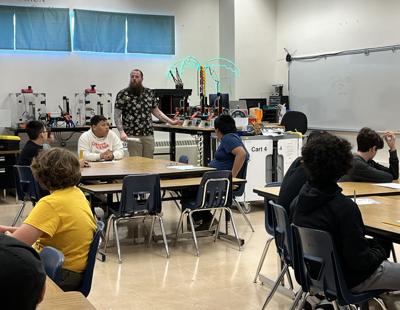The Fairbanks North Star Borough School District Board of Education approved a memorandum Tuesday night that directs any additional state funding it receives toward reducing class sizes.
Last week, the Alaska Legislature passed House Bill 69. After several years of near flat-funding, the bill would provide a $1,000 permanent increase to the Base Student Allocation (BSA), resulting in $5.6 million in new revenue for the district.
The prioritized reinvestment outlined in the memo would only take place if the state increases the BSA by $1,000.
The board’s recommended budget includes sharp cuts and larger class sizes across all grade levels, a reduction in exploratory teachers at Barnette Magnet School, and the loss of two high school counselor positions. It assumes a $680 increase to the BSA.
HB 69 is expected to face a veto from Gov. Mike Dunleavy after the Senate stripped several education policy measures from the bill.
The board approved the memo to show the Alaska Legislature, the governor’s office, and the Fairbanks North Star Borough Assembly how any additional funding would be used.
“The purpose of this was to make sure the Legislature is aware that if they were to pass this $1,000 increase ... that this money would go back to the classroom,” Board President Melissa Burnett said. “The big thing that comes out of Juneau is that they don’t want to give us increases because they don’t believe the money makes it to the classroom.”
She said the memo clearly states that additional funding would be used to lower the pupil-teacher ratio (PTR), or average class size.
Reducing PTR would require an additional $6.1 million. The memo notes that if the state increases transportation funding by at least $270 per student, the district could reallocate $1.5 million currently budgeted to offset a transportation fund deficit.
Funding for Barnette exploratory teachers and high school counselors would depend on any remaining funds. Reinstating those positions would require an additional $634,000.
Under the proposed budget, elementary class sizes would average 26 students; middle school classes would increase by two students to 29; and high school classes would rise from 30 to 32 students per class.
With a $1,000 BSA increase, those numbers would drop — elementary classes would average 24 students, and secondary class sizes would return to current levels.
Superintendent Luke Meinert noted that the impact of increased class sizes is most evident at the high school level, where reduced staffing limits elective options like art, career and technical education, and AP courses.
“Anything the board can do to bring down PTR at the secondary level helps expand the options available to students,” Meinert said.
Response to Instruction debate
Board member Tim Doran proposed including the “Response to Instruction” (RTI) program as an additional item for reinstatement. The RTI initiative had placed tutors and instructional leaders in elementary schools to improve literacy outcomes.
Doran noted that the program was cut years ago due to funding struggles and said relaunching it aligns with the READS Act, a literacy policy adopted in 2022 to improve reading skills in Alaska elementary schools.
“One of the things we struggle with is meeting the intent of small group instruction,” Doran said. “[RTI] impacted all the schools.”
Other board members, including Burnett, disagreed. Burnett said RTI “gets further away from the intent” of the memo, and that other potential add-backs should be discussed separately.
Board member Brandy Harty said that while she appreciated the RTI amendment, the board had already cut 16 math/literacy teaching assistants to save $715,000 in the 2023–2024 budget.
“We wouldn’t be able to get anywhere close to that with what would be left,” Harty said. “A $1,000 increase wouldn’t even cover our PTR reductions.”
Board members Bobby Burgess, Loa Carrol-Hubbard, and Morgan Dulian agreed.
“A simple, direct message is better,” Burgess said. “Adding too much has the potential to create confusion rather than support the argument.”
He added that significant budget cuts have already “reduced choice in our district.”
Doran later argued that if the memo’s intent is to focus solely on PTR, it should not include Barnette teachers and high school counselors as potential reinstatements.
Meredith Maple agreed, saying it “creates a clear and concise document.”
“It prevents us from tying the administration’s hands, since we don’t know what [funding] will actually come through,” Maple said.
Harty disagreed, noting that those specific cuts “were extremely hard to make and will be felt across our district.”
“This is telling the Legislature what we’re going to spend [the extra funding] on,” Harty said.
Doran’s amendment failed in a 5–2 vote, with Maple and Doran voting yes. The overall memorandum passed 6–1, with Doran as the lone dissenting vote.

